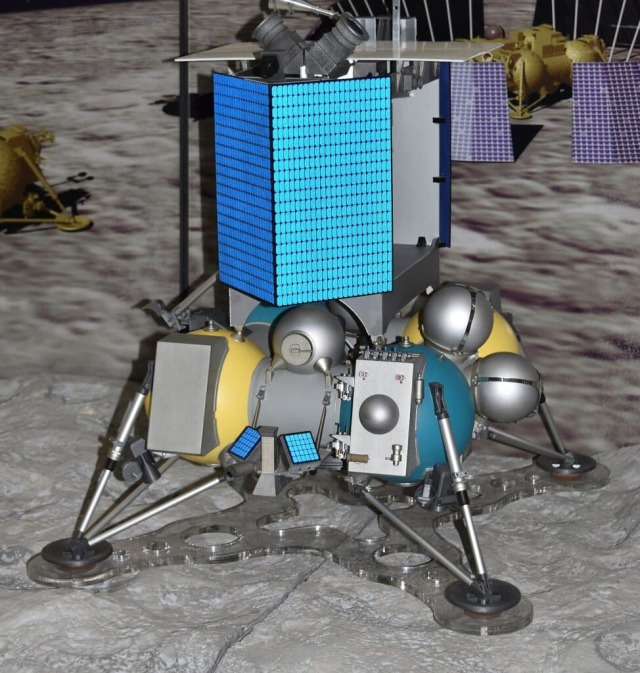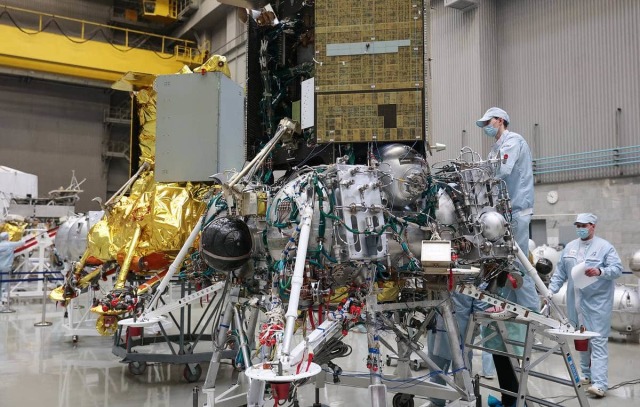The last time Russian cosmonautics reached the lunar surface was almost half a century ago. The mission, the main goal of which is an attempt to repeat the achievement at the modern level, has been worked out for almost 25 years. During this time, Luna-25 has changed the cosmodrome, two carriers and 13 launch dates. Finally, Roscosmos announced a new launch date for this promising automatic interplanetary station, which will almost certainly be able to withstand.
The launch of the Luna-25 spacecraft in 2023 is scheduled for July 13, TASS reported with reference to the press service of the state corporation Roscosmos. The boundaries of the "start window" are not specified, but they cannot be large — a maximum of a couple of days in a month. They are determined by the number of available landing sites, as well as the capabilities of the upper stage and the device itself to adjust its trajectory. If the mission does not start on the scheduled date or the next day, it will be postponed for another month, or even several.
Initially, the launch was scheduled for 2015, but this plan could not be fulfilled. The project was accompanied by technical and organizational difficulties. The device was ready by the end of summer 2021, the launch was scheduled for May 2022. The delay was explained by the need for additional checks of on-board equipment. Later, the launch " went to the right " without explanation for another two months.
By April 2022, the flight of Luna-25 was scheduled for August, tests of all major systems separately, as far as was known, were completed successfully. Then the European Space Agency (ESA) withdrew from the project, and the camera provided by international partners was on the device. She had to test in practice the capabilities of an optical sensor for advanced landing systems in lunar conditions. The absence of this camera cannot affect the lunar landing of Luna-25: in addition to the experimental device, the probe has the appropriate standard equipment.
In a fully assembled condition, with the problems in the propulsion system and on-board equipment eliminated, the AMS went to undergo final pre-launch tests in June. According to the plan, they were supposed to be completed over the summer, but the device did not fly either in August or later.
The Doppler speed and range meter (DISD-LR) failed, which had previously caused delays in the entire project. Eliminating its shortcomings or developing an alternative landing mechanics that takes into account the identified tool errors took time. Roscosmos announced the completion of these works in December 2022, and the launch is planned in 2023.
 |
| Mock-up of the Luna-25 AMC (originally Luna-Globe) at the International Aerospace Salon in Le Bourget, 2015. |
| Source: Pline, Wikimedia |
Despite the adventures described above, the long-suffering mission really has every chance to finally start in the summer of 2024. This is the opinion of the experts interviewed by Kommersant.
Nevertheless, Alexander Khokhlov, a member of the North-Western Organization of the Russian Cosmonautics Federation, fears problems when landing the spacecraft on the moon. In his words, the difficulty is not only in the problematic equipment: "The AMS does not have an active intelligent soft landing system, like the American and Chinese vehicles that land on Mars and the Moon, with an onboard computer and a sensor system." The trouble is that Russia has not sent landing missions to other celestial bodies for too long, valuable experience of such expeditions has been lost.
The scientific task of Luna-25 is to confirm the presence of water in the soil of the circumpolar regions of the Moon. This is important for the further development of the Earth's natural satellite during unmanned and manned missions. Water and volatile compounds in the polar regions of Selenium were detected remotely in the early 2010s by the American Lunar Reconnaissance Orbiter using a Russian-made LAND detector. And the presence of water in the regolith at low latitudes was convincingly confirmed by Luna-24 46 years ago. There should be much more volatile compounds near the poles, so the new mission is of particular scientific and practical interest.
But the first important goal of the Luna-25 project is engineering, because the S. A. Lavochkin NGO has not built such equipment for many decades, experience must be gained literally from scratch. The mass of the device is a little more than one and a half tons (three and a half times lighter than its predecessor), of which most of it is fuel, and it carries about 20 kilograms of payload on board. It includes five scientific instruments and a manipulator arm for taking soil samples and loading them into a spectrometer.
The launch will take place from the Vostochny cosmodrome on a Soyuz-2.1b carrier rocket with a Fregat upper stage.

